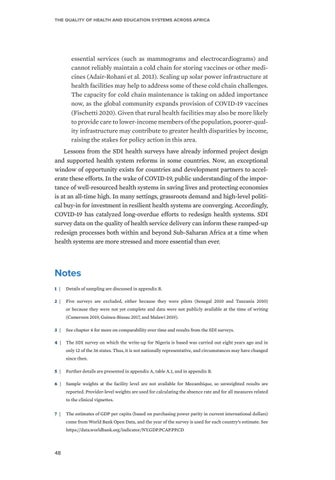The Quality of Health and Education Systems Across Africa
essential services (such as mammograms and electrocardiograms) and cannot reliably maintain a cold chain for storing vaccines or other medicines (Adair-Rohani et al. 2013). Scaling up solar power infrastructure at health facilities may help to address some of these cold chain challenges. The capacity for cold chain maintenance is taking on added importance now, as the global community expands provision of COVID-19 vaccines (Fischetti 2020). Given that rural health facilities may also be more likely to provide care to lower-income members of the population, poorer-quality infrastructure may contribute to greater health disparities by income, raising the stakes for policy action in this area. Lessons from the SDI health surveys have already informed project design and supported health system reforms in some countries. Now, an exceptional window of opportunity exists for countries and development partners to accelerate these efforts. In the wake of COVID-19, public understanding of the importance of well-resourced health systems in saving lives and protecting economies is at an all-time high. In many settings, grassroots demand and high-level political buy-in for investment in resilient health systems are converging. Accordingly, COVID-19 has catalyzed long-overdue efforts to redesign health systems. SDI survey data on the quality of health service delivery can inform these ramped-up redesign processes both within and beyond Sub-Saharan Africa at a time when health systems are more stressed and more essential than ever.
Notes 1 | Details of sampling are discussed in appendix B. 2 | Five surveys are excluded, either because they were pilots (Senegal 2010 and Tanzania 2010) or because they were not yet complete and data were not publicly available at the time of writing (Cameroon 2019, Guinea-Bissau 2017, and Malawi 2019). 3 | See chapter 4 for more on comparability over time and results from the SDI surveys. 4 | The SDI survey on which the write-up for Nigeria is based was carried out eight years ago and in only 12 of the 36 states. Thus, it is not nationally representative, and circumstances may have changed since then. 5 | Further details are presented in appendix A, table A.1, and in appendix B. 6 | Sample weights at the facility level are not available for Mozambique, so unweighted results are reported. Provider-level weights are used for calculating the absence rate and for all measures related to the clinical vignettes. 7 | The estimates of GDP per capita (based on purchasing power parity in current international dollars) come from World Bank Open Data, and the year of the survey is used for each country’s estimate. See https://data.worldbank.org/indicator/NY.GDP.PCAP.PP.CD
48


